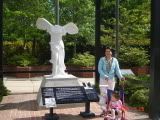B. Procedure
DAY 1 : Chorus Question Game: What have you found?
a. Seat children in a circle.
b. Provide a box patterned like a closet with dress, shirt, blouse, t-shirt, short, pyjama, and other clothing and things inside.
c. Pass to the first child and ask him to select an item from the box.
d. The other children in the group ask “What have you found?”
e. To which the first child replies” I found a…” and put it on.
f. The second child then takes the box and continues the game…
DAY 2: Discussion Proper
a. Seat the children in a rainbow formation.
b. Encourage the children to talk about the topic.
c. Ask open-ended questions.
d. Extend their vocabulary.
e. Record their ideas on the whiteboard explaining that these ideas are to
to be written on the pages of the book they will be going to make.
g. Read aloud as the ideas are written on the whiteboard.
DAY 3: Book Making
a. Let children do printing on the prepared book cover.
b. Select appropriate pictures.
c. Ask the children to paste the pictures on the pages of the book.
d. Ask children to write something about the pictures.
e. Let them draw and colour some illustrations.
f. Let them compile the pages together as in a book.
DAY 4: Reading Proper
a. Ask the first child to read aloud the first page of the children made book.
b. Ask the second child to read aloud the second page.
c. Continue with the rest of the children until all pages have been read aloud and all children have the chance to read aloud.
d. Encourage children to read all the pages of the book.
DAY 5: Storytelling: The Emperor’s New Clothes
A. Before Storytelling:
a. Show and explain how a real book looks like.
b. Discuss the book’s author and illustrator.
c. Explain that they will be hearing a folktale about an emperor and a child who tells the truth.
d. Introduce the children to the main characters and the setting.
e. Discuss the purpose why the children need to listen to the story.
B. During Storytelling:
a. Encourage children to react and comment on the story as they listen.
b. Elaborate the text used.
c. Ask questions occasionally to gauge the children’s comprehension of the story.
d. At certain points in the story, ask children to predict what might happen next.
e. Ask children to voice out their own interpretation of the story.
C. After Storytelling:
a. Review the story components.
b. Discuss how wonderful it is to have lots of books around.
a. Seat children in a circle.
b. Provide a box patterned like a closet with dress, shirt, blouse, t-shirt, short, pyjama, and other clothing and things inside.
c. Pass to the first child and ask him to select an item from the box.
d. The other children in the group ask “What have you found?”
e. To which the first child replies” I found a…” and put it on.
f. The second child then takes the box and continues the game…
DAY 2: Discussion Proper
a. Seat the children in a rainbow formation.
b. Encourage the children to talk about the topic.
c. Ask open-ended questions.
d. Extend their vocabulary.
e. Record their ideas on the whiteboard explaining that these ideas are to
to be written on the pages of the book they will be going to make.
g. Read aloud as the ideas are written on the whiteboard.
DAY 3: Book Making
a. Let children do printing on the prepared book cover.
b. Select appropriate pictures.
c. Ask the children to paste the pictures on the pages of the book.
d. Ask children to write something about the pictures.
e. Let them draw and colour some illustrations.
f. Let them compile the pages together as in a book.
DAY 4: Reading Proper
a. Ask the first child to read aloud the first page of the children made book.
b. Ask the second child to read aloud the second page.
c. Continue with the rest of the children until all pages have been read aloud and all children have the chance to read aloud.
d. Encourage children to read all the pages of the book.
DAY 5: Storytelling: The Emperor’s New Clothes
A. Before Storytelling:
a. Show and explain how a real book looks like.
b. Discuss the book’s author and illustrator.
c. Explain that they will be hearing a folktale about an emperor and a child who tells the truth.
d. Introduce the children to the main characters and the setting.
e. Discuss the purpose why the children need to listen to the story.
B. During Storytelling:
a. Encourage children to react and comment on the story as they listen.
b. Elaborate the text used.
c. Ask questions occasionally to gauge the children’s comprehension of the story.
d. At certain points in the story, ask children to predict what might happen next.
e. Ask children to voice out their own interpretation of the story.
C. After Storytelling:
a. Review the story components.
b. Discuss how wonderful it is to have lots of books around.












0 Comments:
Post a Comment
<< Home